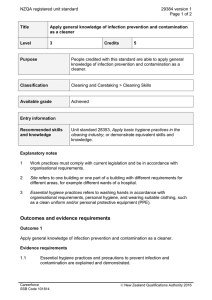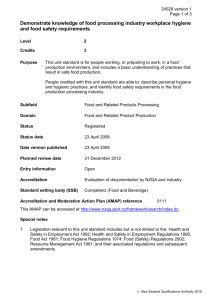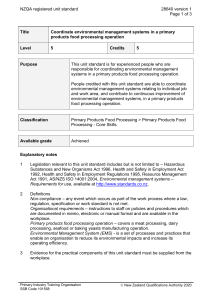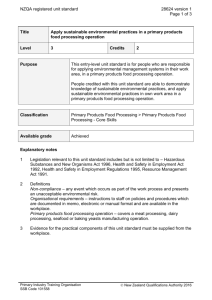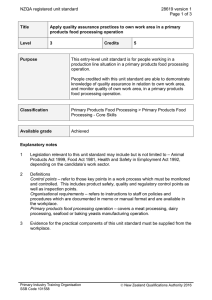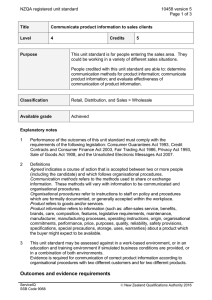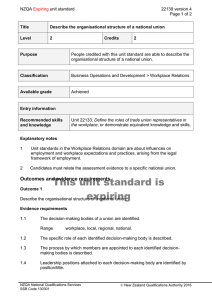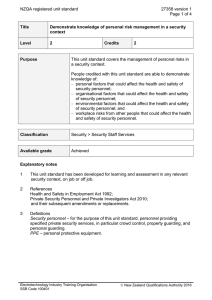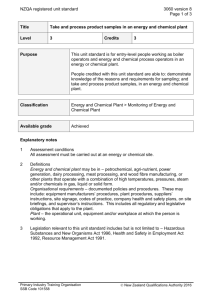NZQA registered unit standard 28630 version 1 Page 1 of 4
advertisement
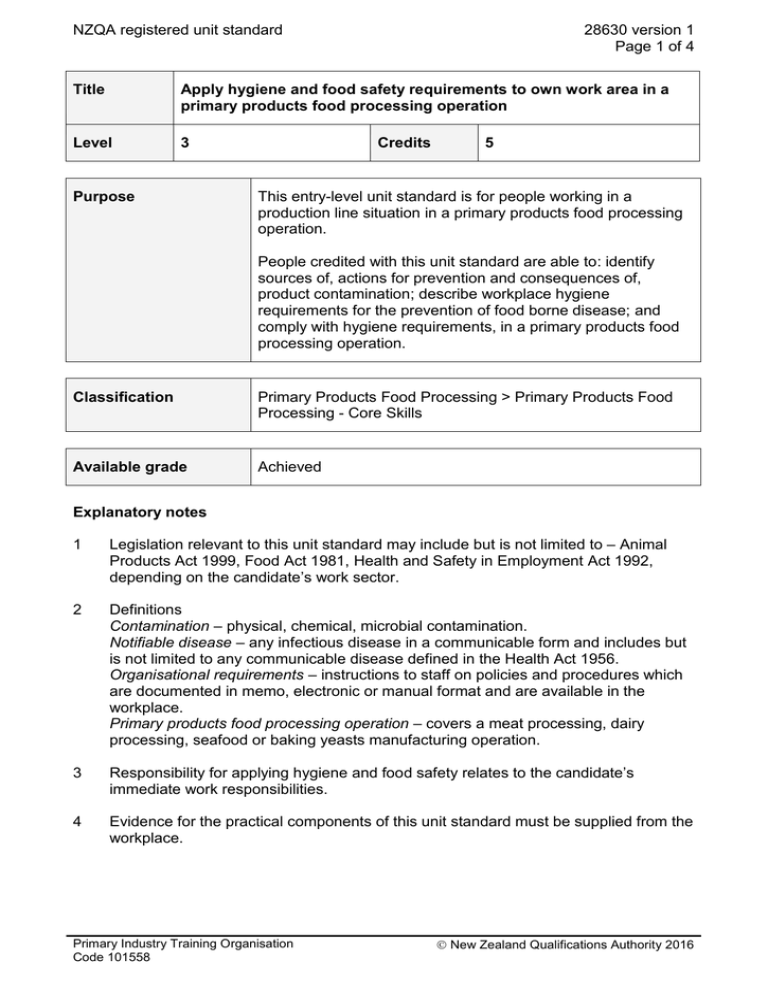
NZQA registered unit standard 28630 version 1 Page 1 of 4 Title Apply hygiene and food safety requirements to own work area in a primary products food processing operation Level 3 Purpose Credits 5 This entry-level unit standard is for people working in a production line situation in a primary products food processing operation. People credited with this unit standard are able to: identify sources of, actions for prevention and consequences of, product contamination; describe workplace hygiene requirements for the prevention of food borne disease; and comply with hygiene requirements, in a primary products food processing operation. Classification Primary Products Food Processing > Primary Products Food Processing - Core Skills Available grade Achieved Explanatory notes 1 Legislation relevant to this unit standard may include but is not limited to – Animal Products Act 1999, Food Act 1981, Health and Safety in Employment Act 1992, depending on the candidate’s work sector. 2 Definitions Contamination – physical, chemical, microbial contamination. Notifiable disease – any infectious disease in a communicable form and includes but is not limited to any communicable disease defined in the Health Act 1956. Organisational requirements – instructions to staff on policies and procedures which are documented in memo, electronic or manual format and are available in the workplace. Primary products food processing operation – covers a meat processing, dairy processing, seafood or baking yeasts manufacturing operation. 3 Responsibility for applying hygiene and food safety relates to the candidate’s immediate work responsibilities. 4 Evidence for the practical components of this unit standard must be supplied from the workplace. Primary Industry Training Organisation Code 101558 New Zealand Qualifications Authority 2016 NZQA registered unit standard 28630 version 1 Page 2 of 4 Outcomes and evidence requirements Outcome 1 Identify sources of, actions for prevention and consequences of, product contamination in a primary products food processing operation. Evidence requirements 1.1 Potential sources of product contamination are identified and described in relation to own work area. Range sources may include but are not limited to – people, environment, materials, ancillary services, product contact surfaces, processing, evidence is required of five sources of contamination. 1.2 Consequences of product contamination are identified and described in terms of potential effects on humans and the market. 1.3 Required actions in relation to notifiable diseases are identified and described in terms of organisational requirements. 1.4 Food safety is described in terms of control of conditions required for growth of food borne disease organisms. Range conditions include but are not limited to – moisture, nutrients, temperature, time, pH. Outcome 2 Describe workplace hygiene requirements for the prevention of food borne diseases in a primary products food processing operation. Evidence requirements 2.1 Hygiene requirements for the prevention of food borne diseases are described in terms of organisational requirements. Range requirements may include but are not limited to – factory hygiene zoning, entry procedures, personal hygiene, clothing and footwear, locker compliance procedure, pest control, cleaning, rubbish disposal, prevention of operator infection, environmental monitoring, maintenance; evidence is required of five requirements. 2.2 The requirements for handling contaminated products are identified and described in terms of organisational requirements. 2.3 Procedures for identifying and reporting unhygienic conditions in the workplace are described in terms of organisational requirements. Primary Industry Training Organisation Code 101558 New Zealand Qualifications Authority 2016 NZQA registered unit standard 28630 version 1 Page 3 of 4 Outcome 3 Comply with hygiene requirements in a primary products food processing operation. Evidence requirements 3.1 Protective clothing is stored, worn, and cleaned or disposed of in accordance with organisational requirements. 3.2 Procedures for entering the processing area are followed in accordance with organisational requirements. procedures may include but are not limited to –boot washing or exchange, hair, jewellery, watches, finger nails, sores and wounds, donning of protective food safety clothing; evidence is required of three procedures. Range 3.3 Hands are washed and/or sanitised in accordance with organisational requirements. 3.4 Hygienic work practices and cleaning procedures are followed in accordance with organisational requirements. Replacement information Planned review date This unit standard replaced unit standard 4817, unit standard 19523 and unit standard 19966. 31 December 2020 Status information and last date for assessment for superseded versions Process Version Date Last Date for Assessment Registration 1 18 June 2015 N/A Consent and Moderation Requirements (CMR) reference 0033 This CMR can be accessed at http://www.nzqa.govt.nz/framework/search/index.do. Please note Providers must be granted consent to assess against standards (accredited) by NZQA, before they can report credits from assessment against unit standards or deliver courses of study leading to that assessment. Industry Training Organisations must be granted consent to assess against standards by NZQA before they can register credits from assessment against unit standards. Providers and Industry Training Organisations, which have been granted consent and which are assessing against unit standards must engage with the moderation system that applies to those standards. Primary Industry Training Organisation Code 101558 New Zealand Qualifications Authority 2016 NZQA registered unit standard 28630 version 1 Page 4 of 4 Requirements for consent to assess and an outline of the moderation system that applies to this standard are outlined in the Consent and Moderation Requirements (CMRs). The CMR also includes useful information about special requirements for organisations wishing to develop education and training programmes, such as minimum qualifications for tutors and assessors, and special resource requirements. Comments on this unit standard Please contact the Primary Industry Training Organisation standards@primaryito.ac.nz if you wish to suggest changes to the content of this unit standard. Primary Industry Training Organisation Code 101558 New Zealand Qualifications Authority 2016
